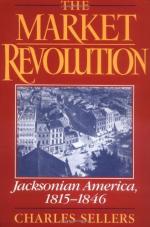
|
| Name: _________________________ | Period: ___________________ |
This test consists of 15 multiple choice questions and 5 short answer questions.
Multiple Choice Questions
1. Where was Andrew Jackson nominated for President?
(a) Florida.
(b) Tennessee.
(c) Kentucky.
(d) Missouri.
2. Where did DeWitt Clinton come from?
(a) Virginia.
(b) New York.
(c) Massachusetts.
(d) Kentucky.
3. What does Sellers attribute Jackson's rise to?
(a) Militarism.
(b) Economic disaffection.
(c) Utopianism.
(d) Expansionism.
4. What step did the Speaker of the House take to expand the American market nationwide?
(a) Tighten immigration restrictions.
(b) Light tariffs on imported goods.
(c) Subsidies for the heartland.
(d) Incentives for railroad developers.
5. How does Sellers characterize Jackson?
(a) Conservative bureaucrat.
(b) Anti-intellectual rabble-rouser.
(c) Ardent nationalist.
(d) Devoted regionalist.
6. What policy did Monroe continue, according to Sellers?
(a) Radicalism about westward expansion.
(b) Relentlessness about relocating Indians.
(c) Bias toward commercial interests.
(d) Ambiguity between farming and commercial interests.
7. Whom did James Monroe replace in the White House?
(a) John Quincy Adams.
(b) Thomas Jefferson.
(c) James Madison.
(d) Andrew Jackson.
8. What kinds of positions does Sellers say became more rare in Jackson's America?
(a) Mercantile positions.
(b) Apprenticeship positions.
(c) Management positions.
(d) Unskilled labor positions.
9. What force does Sellers say created political pressure from the South?
(a) Railroads.
(b) Elite investors.
(c) Cotton industry.
(d) Manufacturers.
10. How does Sellers say Americans reproduced in Jackson's America?
(a) Quickly.
(b) Deliberately.
(c) Slowly.
(d) Steadily.
11. Who was nicknamed Old Hickory?
(a) James Monroe.
(b) Andrew Jackson.
(c) John Adams.
(d) John Quincy Adams.
12. What was James Madison's effect on Thomas Jefferson's pro-land positions?
(a) Expanded them with incentives.
(b) Exacerbated them with tariffs.
(c) Tempered them with markets.
(d) Protected them with regulations.
13. What did the Speaker of the House under James Monroe advocate?
(a) Tight credit supply.
(b) Free trade.
(c) Regulation.
(d) Tariffs.
14. Who felt threatened by the market revolution, according to Sellers?
(a) Big merchants.
(b) Commercial groups.
(c) Large landholders.
(d) Investors.
15. What was the condition of the U.S. in Jackson's time?
(a) Mostly Eastern seaboard territory.
(b) Mostly settled territory.
(c) Mostly open territory.
(d) Mostly agricultural territory.
Short Answer Questions
1. What resulted from the changes that took place under Jackson?
2. What led to the expansion of trade routes, according to Sellers?
3. How does Sellers say James Monroe responded to the expansionism in his government?
4. Who does Sellers blame for the sense that things needed to be reformed?
5. Which group was on the decline by the time Monroe became president?
|
This section contains 377 words (approx. 2 pages at 300 words per page) |

|




